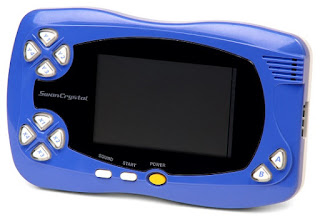 |
| The Original Bandai WonderSwan |
I remember back in the late 90’s, reading an article in the Electronic Gaming Monthly (EGM) magazine about a Japanese handheld being developed by Gunpei Yokoi – who’s the father of the Nintendo Game Boy. Gunpei left Nintendo after the Virtual Boy debacle and formed his own engineering company, Koto Laboratory. Bandai, wanting to enter the video game handheld hardware market after the tremendous success of their Tamagotchi virtual pet, approached Gunpei Yokoi and his company in order to create a new handheld. The Bandai WonderSwan was to be a good, low cost handheld system that ran on just one AA battery.
But before it was released, Gunpei Yokoi died in a car accident… Bandai, not wanting to give up on Yokoi’s project, still went ahead and released the WonderSwan in Japan in 1999. And so, the Bandai WonderSwan was born.
 | |
| Bandai Tamagotchi Digital Pet |
The Bandai WonderSwan runs on a 16 bit NEC V20 CPU, producing a better performance that the Nintendo Game Boy Color. The games were smooth and produced 16 bit graphics that were superior to the Nintendo Game Boy and Game Boy Color. Although the WonderSwan’s screen is Monochromatic, it produced eight shades of gray and looked significantly better than the screen on the original Game Boy. The WonderSwan also had a built-in memory for save games – which was great because the game cartridges need not have batteries for games saves through battery back-up. The handheld also ran on just one AA battery, instead of two for the Game Boy Color and Neo Geo Pocket. The best feature of the WonderSwan by far, was the extra buttons on the upper left side on the machine for playing in portrait mode… It allowed the player to switch from a landscape viewing mode to a portrait mode by turning the handheld and using the extra buttons. The portrait mode was great when playing top down arcade style shoot ‘em ups – which were very popular in Japan.
Bandai later released a color variant named, WonderSwan Color – which featured a color LCD. It was also backwards compatible with the existing game cartridges. It featured a Passive Matrix color LCD, which somewhat hard to see in low light and was prone to blurring. The Nintendo Game Boy Color had a better screen which was an Active Matrix LCD with faster response, brighter and no blurring. So, Bandai released a redesign of the WonderSwan Color called: SwanCrystal. It finally had an Active Matrix LCD which made the games look clearer and brighter with no blurring.
 | |
| The Bandai WonderSwan Color |
 |
| The Bandai SwanCrystal |
The best games for the Bandai WonderSwan series included remakes from Square of Final Fantasy, Final Fantasy 2, and Final Fantasy 4. Some of the best games on this system also included some anime licenses like the Gundam and Digimon franchises from Bandai. A lot of other anime-based games were also released for the WonderSwan. Gunpei Yokoi also developed a puzzle game to compete with Tetris for the WonderSwan called, Gunpey – named by Bandai in his honor. Namco and Capcom also developed great games for the WonderSwan like the Klonoa franchise and Pocket Fighter. Although, the majority of WonderSwan games were in Japanese, some games were in English.
 |
| Gunpey |
 |
| A Final Fantasy WonderSwan Cartridge |
 |
| Final Fantasy WonderSwan gameplay |
I was definitely excited for the WonderSwan’s release back then, knowing that it’s from the genius that created the iconic Nintendo Game Boy… I was hoping for an international release. But, no variant of the Bandai WonderSwan was ever released outside of Japan and became available internationally only in some specialty import shops. Personally, I think it would have been successful internationally, especially in the United States... People in the U.S. have been searching for a good quality, affordable handheld with good games, so there’s demand there.
All in all, the Bandai WonderSwan and its color variants
were great handhelds. They managed to get an 8% marketshare in
Japan, and certainly performed way better than other Game Boy rivals. It’s a
great, affordable, power-efficient video game handheld that would have
succeeded if not for the marketing blunders of Bandai. The Bandai WonderSwan is
an amazing piece of gaming handheld, and will be remembered as being the “true”
successor to the Game Boy, being Gunpei Yokoi's legacy to the gaming world and certainly holds a special place in the history of gaming.
The Bandai WonderSwan and its color variants are still available for sale online. Check below:
The Bandai WonderSwan and its color variants are still available for sale online. Check below:
I haven't heard of the WonderSwan, it has a unique control button.
ReplyDeletewww.vankaizer.com